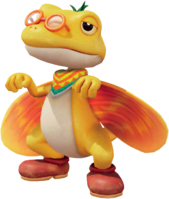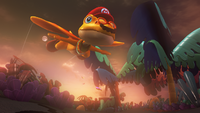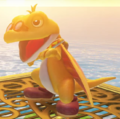Glydon
| Glydon | |
|---|---|
 Artwork from Super Mario Odyssey | |
| First appearance | Super Mario Odyssey (2017) |
- “This spot looks pretty good for a blood-pumping power-dive! Skree-EEEE!”
- —Glydon, Super Mario Odyssey
Glydon is a character in Super Mario Odyssey. He is a creature similar to a draco lizard[1] who is enthusiastic about flying and gliding. His name is a portmanteau of "glide" and "-odon," a typical suffix used for animals (often reptiles, such as Iguanodon and Pteranodon) distinguished or recognized through their teeth (despite Glydon lacking any visible teeth). Mario meets him in five of the game's kingdoms. He states that he is traveling to various kingdoms to glide from the highest places, and the world atlas suggests that he is native to the Sand Kingdom,[2] the first kingdom where he can be found in the game, as suggested as well by his bandana that has similar motifs to the ones on the ponchos of Tostarenans. Glydon does not sink in quicksand, instead repeatedly stomping to stay on the surface. Mario can capture Glydon by using Cappy to use his gliding abilities.
Glydon is always found in high locations in each kingdom, both fitting his personality and maximizing the use of his gliding ability. However, he appears in a kingdom only after the last objective in it is complete. The locations are:
- The Tostarena Ruins Round Tower in the Sand Kingdom.
- The Observation Deck in the Wooded Kingdom.
- The Rocky Mountain Summit in the Lost Kingdom.
- The Lighthouse in the Seaside Kingdom.
One exception is for the Darker Side, where Glydon is required to complete Long Journey's End. He appears as part of the underground section of the kingdom.
While Glydon is captured, his quicksand immunity still applies. Glydon can jump, and holding the jump button lets him glide through the air. He can do a short jump with or
instead. If the controller is shaken, Glydon does the short jump but does not glide. Glydon can turn while gliding, but he loses altitude faster when taking sharp turns. While Glydon is gliding, shaking the Joy-Con or Pro Controller makes him stay airborne longer. If
is held forward, Glydon tucks his arms in and dives, plummeting quickly with lesser directional control compared to normal. Alternatively, the player can hold
backward to have Glydon lean back and stall the glide's speed. Wind can push Glydon upward, extending the glide's distance. If Glydon collides with walls, his glide is forced to end. As such, he cannot start gliding with a wall in his path. Camera movement is heavily restricted while Glydon is gliding, with the angle largely set to be ahead of him in a base glide, and below him while he is diving or stalling.
Glydon's gliding abilities are the only way to obtain two Power Moons located far across pits or poison that Mario cannot cross with any normal moves. In the Lost Kingdom, this is the "Soaring Over Forgotten Isle!" Power Moon. In the Wooded Kingdom, Mario has to speak to Captain Toad on one far-off platform to get the "Hey Out There, Captain Toad!" Power Moon. In the Seaside Kingdom, the player can use Glydon to glide from the top of the Lighthouse toward the Glass Palace. This impresses a Bubblainian on the palace. After the player talks to them, they grant the player the "Lighthouse Leaper" Power Moon. Aside from these explicit requirements, Glydon's abilities are an option in many of the game's scenarios.
While Glydon has been stated to be a character by the official Super Mario UK Twitter account,[3] both the official Prima Games guide of Super Mario Odyssey and the official Super Mario Italian Twitter account indicate that Glydon is a species.[4][dead link][5]
Gallery[edit]
Artwork[edit]
Postcard obtained as reward in Super Mario Odyssey
Screenshots[edit]
Glydon in the Sand Kingdom
Glydon captured by Mario diving in the Wooded Kingdom
Glydon in the Seaside Kingdom
Glydon with Mario in the Lost Kingdom
Glydon on the Darker Side
Names in other languages[edit]
| Language | Name | Meaning | Notes |
|---|---|---|---|
| Japanese | カックー[?] Kakkū |
From「 「カックー」is also a nickname for names beginning with Kaku-.1 Both meanings have different accents (Kakkū for "gliding" and Kakkū for the nickname) |
|
| Chinese | Huáxiáng xiǎozi |
Glide Boy | |
| Dutch | Glydon[?] | - | |
| French | Planodon[?] | From planer ("to glide") and -anodon ("toothless") | |
| German | Segelmander[?] | Portmanteau of segeln ("to glide") and "salamander" | |
| Italian | Planosauro[?] | From planata ("glide") and -sauro ("lizard") | |
| Korean | 날돈[?] Naldon |
From 날개 (nalkae, "wing") or 날다 (nalda, "to fly"), and -don (a suffix used for dinosaurs) | |
| Russian | Птеродон[?] Pterodon |
From the Russian transcription of the Greek words |
|
| Spanish | Planeosaurio[?] | From planeo ("glide") and -saurio ("lizard") |
1 - For example, Katsuya Kakunaka, a professional baseball player for the Chiba Lotte Marines, Japan, as of 2022, is occasionally called Kakkū by his fans, although his official nickname is Kaku. Also, Hollow Dogū, a clay figure found in Hakodate, Hokkaido, and a mascot character based on it have the same nickname, Kakkū, named after Minamikayabe (the place where it was discovered) and kūdō (hollow).
See also[edit]
References[edit]
- ^ Nintendō Kōshiki Gaidobukku Sūpā Mario Odessei (Nintendo Official Guidebook Super Mario Odyssey,「
任天堂 公式 ガイドブック スーパーマリオ オデッセイ」), page 20. Shogakukan. Retrieved December 19, 2017. - ^ Current World atlas of Super Mario Odyssey.
- ^ Post about Glydon from the official Super Mario UK Twitter account.
- ^ Super Mario Odyssey eGuide
- ^ Post about Glydon's increased reach when shaking the Joy-Cons. The text says If you shake the Joy-Cons while sailing the skies as a Glydon, you will be able to fly a little farther!.








